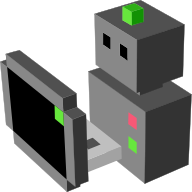import logging; logger = logging.getLogger("morse." + __name__)
import math
import morse.core.sensor
from morse.helpers.components import add_data, add_property
from morse.core.mathutils import Vector
from morse.helpers.velocity import linear_velocities, angular_velocities
from morse.helpers.transformation import Transformation3d
[docs]class Accelerometer(morse.core.sensor.Sensor):
"""
This sensor emulates an Accelerometer/Podometer, measuring the
distance that a robot has moved, the current speed and current
acceleration. Measurements are done for the 3 axes (X, Y, Z) for
velocity and acceleration. The values for velocity and acceleration
are measured at each tic of the Game Engine, measuring the
difference in distance from the previous tic, and the estimated time
between tics (60 tics per second is the default in Blender).
"""
_name = "Accelerometer"
add_data('distance', 0.0, "float",
'distance travelled since the last tick, in meter')
add_data('velocity', [0.0, 0.0, 0.0], "vec3<float>",
'Instantaneous speed in X, Y, Z, in meter sec^-1')
add_data('acceleration', [0.0, 0.0, 0.0], "vec3<float>",
'Instantaneous acceleration in X, Y, Z, in meter sec^-2')
add_data('angular_acceleration', [0.0, 0.0, 0.0], "vec3<float>",
'Instantaneous acceleration in X, Y, Z, in meter sec^-2')
add_property('_type', 'Automatic', 'ComputationMode', 'string',
"Kind of computation, can be one of ['Velocity', 'Position']. "
"Only robot with dynamic and Velocity control can choose Velocity "
"computation. Default choice is Velocity for robot with physics, "
"and Position for others")
def __init__(self, obj, parent=None):
""" Constructor method.
Receives the reference to the Blender object.
The second parameter should be the name of the object's parent.
"""
logger.info('%s initialization' % obj.name)
# Call the constructor of the parent class
morse.core.sensor.Sensor.__init__(self, obj, parent)
self.pp = Transformation3d(None) # previous position
self.plv = Vector((0.0, 0.0, 0.0)) # previous linear velocity
self.pav = Vector((0.0, 0.0, 0.0)) # previous angular velocity
self.pt = 0.0 # previous timestamp
self.dt = 0.0 # diff
has_physics = bool(self.robot_parent.bge_object.getPhysicsId())
if self._type == 'Automatic':
if has_physics:
self._type = 'Velocity'
else:
self._type = 'Position'
if self._type == 'Velocity' and not has_physics:
logger.error("Invalid configuration : Velocity computation without "
"physics")
return
# imu2body will transform a vector from imu frame to body frame
self.imu2body = self.sensor_to_robot_position_3d()
# rotate vector from body to imu frame
self.rot_b2i = self.imu2body.rotation.conjugated()
if self.imu2body.translation.length > 0.01:
self.compute_offset_acceleration = True
else:
self.compute_offset_acceleration = False
if self._type == 'Velocity':
# make new references to the robot velocities and use those.
self.robot_w = self.robot_parent.bge_object.localAngularVelocity
self.robot_vel = self.robot_parent.bge_object.worldLinearVelocity
logger.info('Component initialized, runs at %.2f Hz', self.frequency)
def _sim_simple(self):
v = linear_velocities(self.position_3d, self.pp, self.dt)
w = angular_velocities(self.position_3d, self.pp, self.dt)
a = (v - self.plv) / self.dt
aw = (w - self.paw) / self.dt
# Update the data for the velocity
self.plv = v.copy()
self.pav = w.copy()
# Store the important data
w2a = self.position_3d.rotation_matrix.transposed()
self.local_data['velocity'] = w2a * v
self.local_data['acceleration'] = w2a * a
self.local_data['angular_acceleration'] = w2a * aw
def _sim_physics(self):
w2a = self.position_3d.rotation_matrix.transposed()
# rotate the angular rates from the robot frame into the imu frame
rates = self.rot_b2i * self.robot_w
# differentiate linear velocity in world (inertial) frame
# and rotate to imu frame
a = w2a * (self.robot_vel - self.plv) / self.dt
if self.compute_offset_acceleration:
# acceleration due to rotation (centripetal)
# is zero if imu is mounted in robot center (assumed axis of rotation)
a_centripetal = self.rot_b2i * rates.cross(rates.cross(self.imu2body.translation))
#logger.debug("centripetal acceleration (% .4f, % .4f, % .4f)", a_rot[0], a_rot[1], a_rot[2])
# linear acceleration due to angular acceleration
a_alpha = self.rot_b2i * (self.robot_w - self.pav).cross(self.imu2body.translation) / self.dt
# final measurement includes acceleration due to rotation center not in IMU
a += a_centripetal + a_alpha
aw = (rates - self.pav) / self.dt
# save velocity for next step
self.plv = self.robot_vel.copy()
self.pav = self.robot_w.copy()
self.local_data['velocity'] = w2a * self.robot_vel
self.local_data['acceleration'] = a
self.local_data['angular_acceleration'] = w2a * aw
[docs] def default_action(self):
""" Compute the speed and accleration of the robot """
# Compute the difference in positions with the previous loop
self.dt = self.robot_parent.gettime() - self.pt
self.pt = self.robot_parent.gettime()
if self.dt < 1e-6:
return
self.local_data['distance'] = self.position_3d.distance(self.pp)
logger.debug("DISTANCE: %.4f" % self.local_data['distance'])
if self._type == 'Velocity':
self._sim_physics()
else:
self._sim_simple()
# Store the position in this instant
self.pp = self.position_3d
